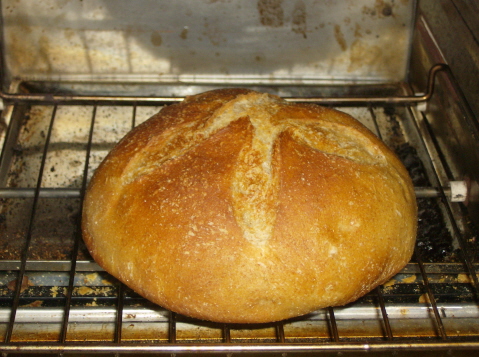What is this? Loaves made with commercial yeast, no pre-ferment, and all commercially ground flour? I'm flashing back.
Must...use...only...iceberg...lettuce...in...the...salad.
Can...not...find...love beads.
But I promised I would try this as part of the baguette surprise and challenge. It was like riding a bike. How fast those commercial yeasts do their little thing! (6 hours from scaling to bread and 2 of that was my slow mixing!) How easy!
I made my standard baguette formula (65% hydration) adapted to commercial yeast. I feel that my % of yeast - which was .5% - was a bit high, but looking at dmsynder's formula it seemed ok.
I did not use any whole wheat flour because I wanted to go "single factor" on this try - my sourdough baguettes vs. commercial yeast.
I've written up the technique and formula before and I followed it as only I can (like a maniac) - although I did have to adjust the timings for the bulk ferments (1 hour, fold, 1 hour) and proofing (40 minutes). Shaping went "as usual" - I did not try to be especially light in my shaping although I have been told that I have a "light but firm" hand "naturally" (yeah, after years of practice...). I got a little distracted during the scoring, but steamed and baked as usual.
Oh my goodness! The oven spring! I remember when bread sprang quite like that! This commercial yeast is the bee's knees! No wonder so many people use it! Wow!
Here' a picture of the cooling loaves where my haste in scoring is clearly evident. But even so, the slashes opened well and have some nice grigne. Alas, it seems that no yeast wild or commercial will improve my photography skills, though.

I did NOT leave them in the turned off oven for 5 minutes, as again, I wanted to go all single factor on this. When the loaves came out of the oven the crust was crackly and fragile. I kept poking my fingers through it as I squeezed the loaves to test doneness and it came off in flakes. As the loaves cooled, however, they lost the crackly quality somewhat. I really think the slower cooling has some virtues and some role to play in that "crackly crust." (I also now think that excess steam is the culprit on cuts not opening...)
Here are a couple of crumb shots. The crumb is not as open as my normal baguette, but it is not horrific. The slashing flaws have a role to play there.


The bread had a "fluffy" feeling when I bit into it. Very soft and springy as compared to my normal levain baguette.
And the taste? Well, bland. Nice, sweet, wheaty, no hint of yeast, but bland. This would make a lovely "carrier bread" as far as I am concerned - some really good butter and jam would go nicely and is almost required. I'd gladly toast it up for a breakfast tartine. Remember that I haven't eaten any breads not produced with wild yeast in at least three years now, so my perspective is somewhat skewed. But so easy! This commercial yeast is the best things since - well, since sliced bread!
(Seriously, you can see why bakers, pressed to get bread on the shelves for morning customers, embraced this marvelous yeast when it first appeared. Taste? Close enough. People will eat it if that's all we sell and if we sell it warm, who will know? For my personal baking I would never forgo the preferment - even using commercial yeast - because it is just so easy to do and can be done during non working hours. But for speed from mixing to baked loaf after long centuries of baking with wild yeast, this must have been viewed with tremendous enthusiasm.)
At some point I will try the 10% whole wheat. I mean, why not? The whole process is so fast...
David, I hope my experiences are helpful to you in some small way.
Happy Baking!










